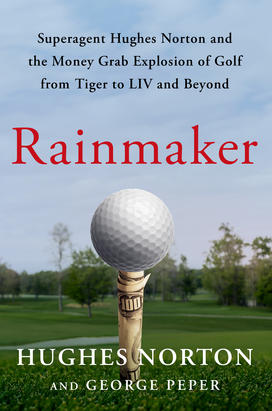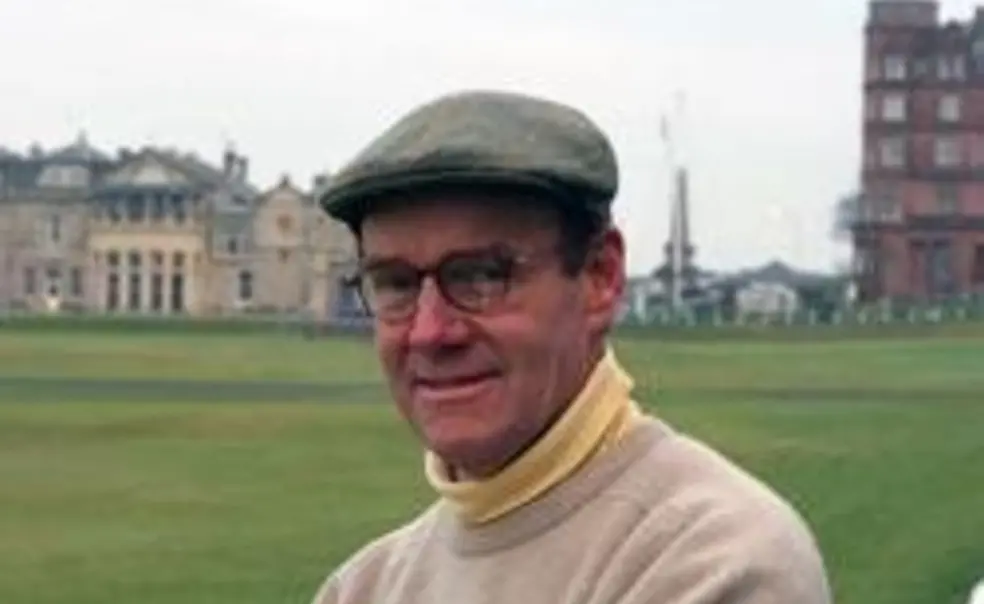George Peper ’72 Collaborates on New Book about Legendary Golf Agent Hughes Norton
The book: In a new tell-all book, Rainmaker (Atria Books), Hughes Norton discusses his rise and fall as an agent in the golf world. At the height of his career while working with Tiger Woods, Norton earned a million-dollar salary and enjoyed a lavish lifestyle as part of his wild success. But the glitz and glamour came with long work weeks, intense pressure, and more that led to the demise of Norton’s marriage. A must for golf lovers, Rainmaker gives a behind the scenes look at a figure who made it big in the industry — until his career at that time came to a controversial end.

The authors: George Peper ’72 earned his undergraduate degree from the University in English. He was the editor-in-chief of Golf Magazine for 25 years, and now serves as an editor for Links magazine. He’s the bestselling author of 19 books including The 500 World’s Greatest Golf Holes and The Story of Golf.
Hughes Norton is a sports agent who has worked with a number of greats on the course including Tiger Woods and Greg Norman. He’s been named one of the Most Power 36 People in Golf by Golf Digest. Norton currently resides in Chagrin Falls, Ohio.
Excerpt:
Prologue
On August 28, 1996, two words changed golf forever. That day, 22-year-old Tiger Woods stepped to the podium at the Greater Milwaukee Open. As dozens of flashbulbs popped, he smiled widely, if sheepishly, and uttered his first words to the public since turning professional two days earlier: “Uh . . . I guess . . . Hello, world, huh?” Those assembled laughed, clearly charmed by what appeared to be a spontaneous statement.
It was anything but. Two days later Nike launched an ad campaign with a three-page spread in the Wall Street Journal and a series of 30- and 60-second spots on CBS and ESPN, all carrying the same message: I shot in the 70s when I was 8. I shot in the 60s when I was 12. I played in the Nissan Open when I was 16. Hello world. I won the U.S. Amateur when I was 18. I played in the Masters when I was 19. I am the only man to win three consecutive U.S. Amateur titles. Hello world. There are still courses in the U.S. I am not allowed to play. Because of the color of my skin. Hello world. I’ve heard I’m not ready for you. Are you ready for me?
It was a message that sparked controversy and even boycotts. But it also reached a generation of younger consumers as no golf ad ever had. At that moment, the game of golf became cool, and very big business. The evening before, I’d knocked on the door of a hotel suite where Tiger and his father, Earl, were waiting for me. Moments later the three of us signed three groundbreaking contracts: (1) a five-year, $40 million agreement with Nike for Tiger to wear their shoes and apparel; (2) a $20 million agreement with Titleist to play their golf balls and clubs, also for five years; and (3) an agreement to be represented by my firm, International Management Group, for an unprecedented 10-year term. It was a huge moment for Tiger Woods—but just one of many more to come. For me, on the other hand, it was a crowning achievement. No agent in the history of sports—or anything else—had ever delivered so mightily for a client on the first day of his professional career. I’d hit the pinnacle, climbed to the mountaintop, and I was loving the view. Two years later, I’d be out of a job.
Chapter 1
Saturday, July 11, 1970
The Old Course
St. Andrews, Scotland
On the final hole of the 99th Open Championship, 36-year-old Doug Sanders faced a putt to beat Jack Nicklaus, to become the Champion Golfer of the Year. The biggest putt of his life, it was less than three feet.
The thousands of spectators ringing the green, along with the millions watching on television, held their breath as the flamboyant Californian, clad in purple from head to toe, surveyed his task from both sides and then hunched over the ball.
The stroke he made was painful to witness—a convulsive stab that pushed the ball so far right it never touched the cup. The following day, in an 18-hole playoff with Nicklaus, Sanders lost by a stroke as Jack notched the eighth of his record 18 major titles.
On that same weekend, precisely 3,000 miles to the west, another competition took place—the men’s championship of the Portland Country Club—and, as at St. Andrews, it came down to a short putt and the jittery fellow standing over it: me
My opponent was Ray Lebel, a 47-year-old oral surgeon, World War II navy fighter pilot, and father of seven. To call him the “Jack Nicklaus of Maine Golf” would be demeaning Ray. A member of the Maine Sports Hall of Fame, he’d won the state amateur seven times. Inside the Portland clubhouse, on a plaque honoring past champions, “Dr. R. Lebel” had made 25 appearances, including 12 of the previous 13 years. (I’m not sure what happened in 1961— maybe he had jury duty.) Ray would ultimately win 32 Portland Country Club titles, along with 15 more at a handful of other clubs, for a total of 47 club championships. According to Golf Digest, that’s the all-time record.
I was half his age, a wiry five-ten and 160 pounds with a 5 handicap and a self-taught swing. I lacked Lebel’s stature in every sense. On a really good day I could bump it around Portland’s 6,200 yards in something close to par, but I was no match for Ray. Two years earlier, I’d made it to the final against him and he’d beaten me 7 and 6. Suffice it to say, I wasn’t brimming with confidence as we shook hands on the first tee that Saturday in 1970.
But somehow, after 17 holes we were all square. I don’t recall much about our match except that I double-bogeyed the par-4 fifteenth and got away with it, as Ray, in a rare lapse, also made a 6. The 18th was a reachable par-5, and a solidly struck 3-wood got me home in two, pin high and about 30 feet from the hole. Ray, after outdriving me, came up short on his second shot and then played a mediocre pitch (by his standards) that settled on the front of the green, a bit farther from the hole than I was. He was now putting for birdie, while I had a look at eagle.
A handful of club members were watching all this, including my mother, along with my aunt and uncle, who were visiting us. My regular golf buddies were absent; knowing I’d had my ass kicked by Ray the last time, they’d opted out rather than bear witness to a second brutal slaying.
Ray’s putt burned the edge before stopping a foot away. So my situation was clear: two putts for victory. Of course, the only thought in my mind was “For God’s sake, don’t three-jack—if you have to go extra holes with this guy, you’re toast.” Despite that less than buoyant inner monologue, I was able to hit a solid putt, but a bit too solid, as it stopped just beyond the hole.
I had about three feet, slightly downhill, with a bit of slide to the right—the same putt Doug Sanders had faced. I took a deep breath and managed to shake it into the hole. (Do you really think I’d be telling this story if I’d missed it?)
I remember thinking, Has this really happened? Indeed, more than half a century later I still look back at that day as my most surreally blissful moment on a golf course. On that blessed afternoon, the game I so loved had decided to love me back.
Word got around the club. It wasn’t long before my pals came out of the woodwork to offer incredulous congratulations. We were having a beer in the locker room when one of them said, “Hey, we need to go out and celebrate!”
“I’d love to,” I said, “but I’m on the air in 45 minutes.”
Excerpted from Rainmaker Copyright (c) 2024 by Hughes Norton and George Peper. Republished with permission of the publisher, Atria Books. All rights reserved.
Reviews:
“This is the most amazing ‘behind the curtain’ view ever written about the world of sports management. Hughes was the guru to some of the greatest golfers in the world — it wasn’t by accident.” — Jim Nantz, CBS Sports
“Wow, what a read—an inside look at pro golf and the players who have dominated it, from Palmer and Nicklaus to Norman and Tiger and everyone in between. No one knows better than Hughes Norton how golf evolved from a mom-and-pop operation to the behemoth it is today, and he spares no one in telling his story, including himself. This book may rankle a few people, but it’s all the truth.” — Curtis Strange, professional golfer












No responses yet